Bennemann K.H., Ketterson J.B. Superconductivity: Volume 1: Conventional and Unconventional Superconductors; Volume 2: Novel Superconductors
Подождите немного. Документ загружается.

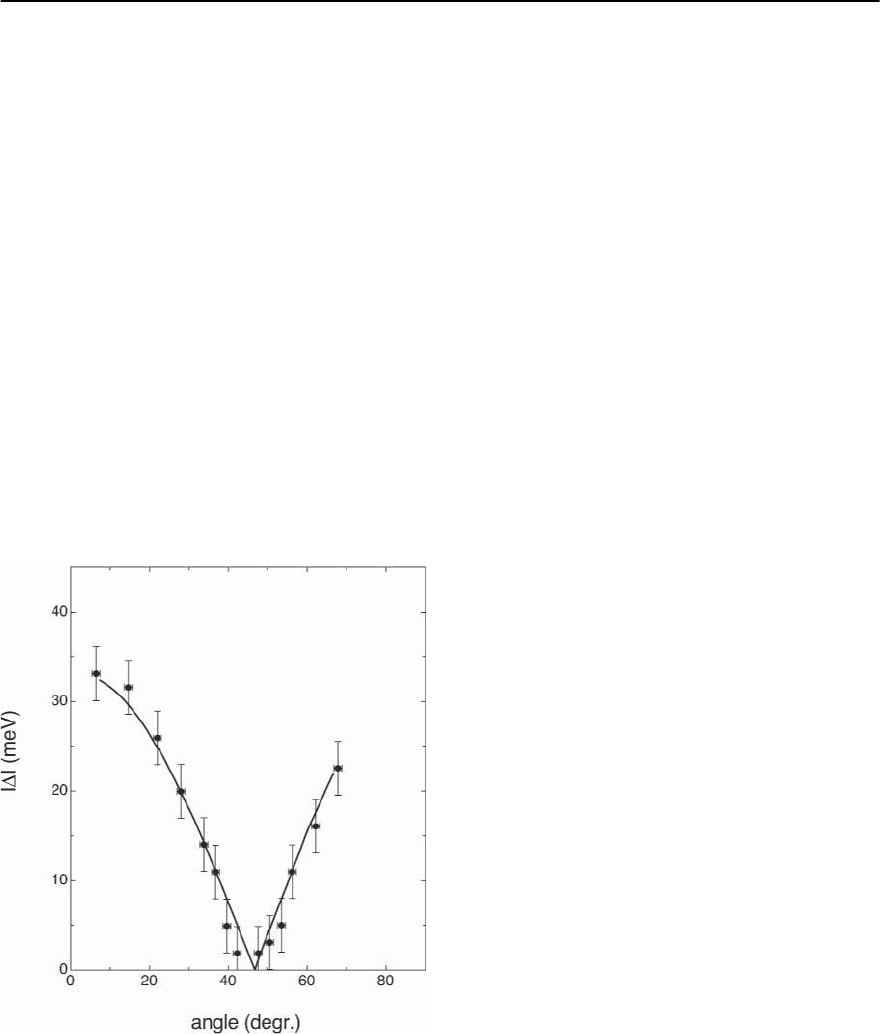
14 High-T
c
Superconductivity 807
is not significantly reduced below T
c
[217].The main
influence of agap functionwith nodesis again visible
in a non exponential decay of K(T)atlowtempera-
tures.
In Fig. 14.60 a selection of results of Knight shift
measurements involving nuclei on different lattice
sites of YBCO-123 is presented [218,219]. The strong
reduction of K in the superconducting state clearly
reflects spin singlet pairing. Together with the infor-
mation suggesting the existence of line nodes in the
gap function, there is strong evidence for a d-wave
type pairing being established in cuprate supercon-
ductors. Theoretical model calculations to account
for the experimental data gave better agreement,if d-
wave rather than s -wave pairing was assumed [191].
One such attempt is shown as the broken line in
Fig. 14.60.
(e) Angle Resolved Photoemission
As was mentioned above, significant progresses
in measurements employing photoemission spec-
troscopy techniques, in particular ARPES with high
Fig. 14.61. Angle dependence of the leading-edge shift in
ARPES spectra of Bi-2212, relative to the position of the
reference Fermi edge of Pt. The solid line represents a cal-
culation assuming a d-wavetypegapfunction(see[87])
energy and momentum resolution, were respon-
sible for the evaluation of the excitation spec-
trum of quasiparticles in cuprate superconductors.
While integrative photoemission has been able to
demonstrate the formation of a gap below T
c
[85],
ARPES also provides information concerning the k-
dependence of the gap. Since a whole chapter of
this compendium is dedicated to this type of exper-
iments, it suffices for our purposes to present the
results of ARPES measurements probing (k)(see
Fig. 14.61). The fourfold symmetry of the node con-
figuration expected for a gap function with d
x
2
−y
2
symmetryisverywellborneout[87].
(f) Phase Sensitive Measurements
The experiments cited and discussed above all con-
firm that the gap functions in the investigated
cuprate superconductors exhibit nodes, most likely
on lines, and that the pairing state of the quasiparti-
cles is of a spin-singletvariety.All this takentogether,
also taking into account the essential electronic wave
functions in the Cu-O planes and considering vari-
ous theoretical arguments based on phenomenolog-
ical and computational approaches [191] leads to the
conjecture that the pair state and hence the order pa-
rameter as well as the gap function exhibit a d
x
2
−y
2
symmetry. This implies that the amplitude of the or-
der parameter changes sign at the nodes or,in other
words, the phase of the order parameter changes dis-
continuously by . None of the above experiments
is sensitive to this phase change and other types of
measurements have to be invoked to settle this issue.
These measurements have to be devised such that
they probe the relative phase of the gap function on
different parts of the Fermi surface.
Since phase information is required, this type of
experiments is based on the macroscopic quantum
coherence in superconductors,most distinctly man-
ifested in the Josephson effects and the flux quan-
tization. The concept for this kind of tests has first
been put forward by Geshkenbein and Larkin [220],
in connection with probing the unconventional na-
ture of superconductivity of heavy electron metals.
They suggested to investigate the phase coherence
of specially tailored superconducting loops contain-
ing a combination of the superconductor under in-
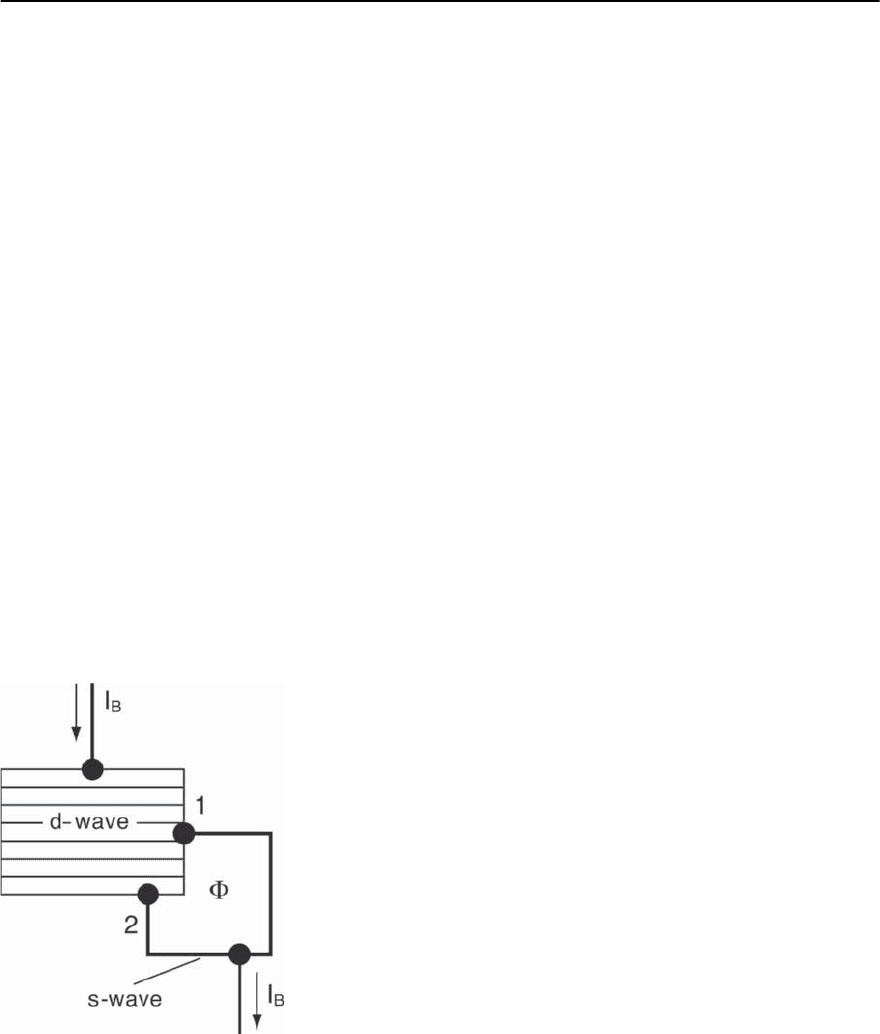
808 H.R.Ott
vestigation and conventional superconducting ma-
terials. This idea was later adapted by Sigrist and
Rice [221] for a proposal to test the d
x
2
−y
2
character
of the gap function of cuprate superconductors and
the schematic layout of the required superconduct-
ing loop is shown in Fig. 14.62.The idea rests on the
fact that at a Josephson contact between two super-
conductorswith opposite signs of their order param-
eter amplitudes, a so called -junction [222], where
the phase of the order parameter changes discontinu-
ously by ,is generated.It is well known thatthe mag-
netic flux through the cavity of aclosed loopof a sin-
gle conventional superconductor is quantized [223];
theflux quantum is ¥
0
=hc/2e.Itturnsoutthatthere-
sponse to external magnetic fields of loops contain-
ing either an even (including zero) or odd number of
-junctions is significantly different.In the firstcase
the highest stability is achieved if an integer num-
ber of flux quanta ¥ = · ¥
0
is trapped in the loop.
In the second case,however,the stability criterion re-
quires that ¥ =( +1/2)·¥
0
.Essentially two different
types of experiments have been designed to obtain
the requested information. In this more general re-
view,noneof theintricaciesof theseexperimentsand
their analyses will be addressed in detail. This has, to
a large extent,been done in more specialized reviews
on this topic [224,225] (see below).
Fig. 14.62. Schematic layout of a superconducting loop for
phase sensitive tests of the order parameter symmetry of
cuprate superconductors, employing a SQUID type config-
uration (see [221])
(f1) SQUID-Type Experiments
Superconducting quantum interference devices
(SQUIDs) are based on the Josephson effect, i.e., on
the tunneling of pairs as a whole and usually contain
two Josephson contacts in parallel. As the name in-
dicates,SQUIDs offer the possibility of experimental
control of the phase of the macroscopic wave func-
tion describing the superconducting state. For our
purposes the chosen loop may be manufactured in
a SQUID configuration, as is schematically outlined
in Fig. 14.62. The design is such that one, two or
none of the contacts may form as a -junction.The
critical current I
c
, i.e., the maximum supercurrent,
varies periodically as a function of the total mag-
neticfluxinsidetheloop.Thelocationofthemax-
ima or minima of I
c
depends critically on the phase
coherence around the loop. If the SQUID loop con-
tains none or two -junctions, an I
c
(¥ ) pattern as
shown in Fig. 14.63a is expected. The I
c
(¥ )diagram
for a SQUID with only one -contact, however, is
shifted by along the horizontal ¥ -axis, as shown
in Fig. 14.63(b). The first realization of this type of
SQUID experiments was accomplished by Wollman
and co-workers [226] by studying the critical cur-
rent behavior of SQUIDs that were fabricated from
single crystalline YBCO-123 and Pb.The Pb part was
in the form of a thin film, deposited in two differ-
ent configurations. In the first, the film made two
contacts around the corner of a single crystal, such
that one of them is along the a direction and the other
along the b direction of the crystal lattice.The second
configuration had both contacts onto the same edge
of the crystal, facing the same crystallographic di-
rection.The schematic sample configuration for this
pioneering work is shown in Fig. 14.64. Considering
the crystal structure of YBCO-123 and the expected
d
x
2
−y
2
symmetry of theorder parameter,the first con-
figuration is expected to contain one contact acting
as a -junction. For the second case either none or
two -junctions are likely tobe established.Measure-
ments of the dynamical resistances of these SQUIDs
as a function of applied magnetic field were used
to monitor the modulation of the I
c
(¥ )curves.The
analysis of the data indicated a tendency of a -shift
of I
c
(¥ ) for loops around the corner of the crystals
with respect toI
c
(¥ ) obtained for edge-typeSQUIDs.
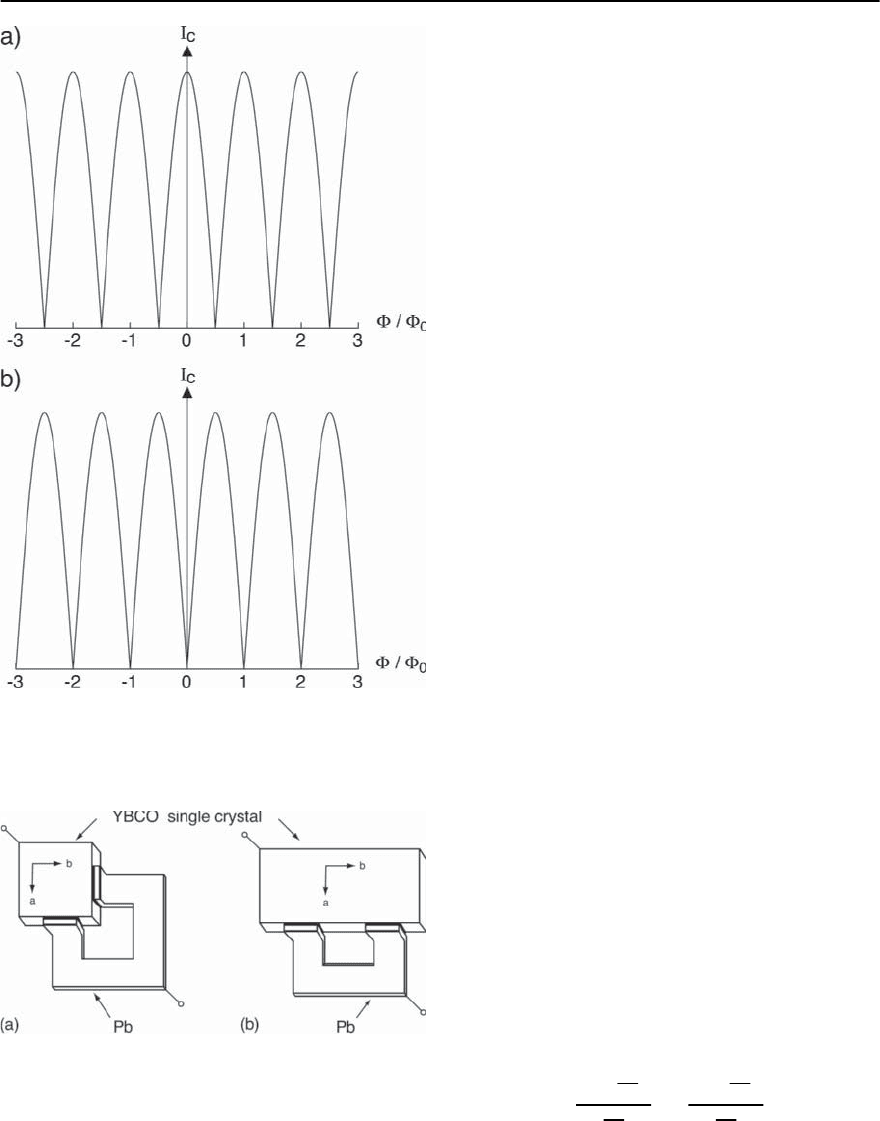
14 High-T
c
Superconductivity 809
Fig. 14.63. Interference patterns of the critical current I
c
ofa
superconducting loop as shown schematically in Fig.14.62,
upon varying the magnetic flux through the loop (a) with
an even or (b) an odd number of -junctions (see text)
Fig. 14.64. Schematic view of the experimental realization
of SQUID type configurations forming (a) acornerSQUID
and (b) an edge SQUID for phase aensitive tests of the or-
der parameter symmetry of Y-123 single crystals see [224]
The result was thus regarded as a confirmationof the
d
x
2
−y
2
character of the order parameter of this mate-
rial. In another approach [227], a direct comparison
of the field induced critical current variation of a hy-
brid SQUID fabricatedfrom single crystallineYBCO-
123 and Nb,expected to contain one -junction,with
I
c
(¥ ) of two control SQUIDs made of Nb alone was
made.This comparison of I
c
(¥ ) of the two configura-
tions, accomplished by simultaneous measurements
of the dynamical resistances, again gave evidence for
a -shift between the I
c
(¥ )curvesofthetwotypes
of SQUIDs.Additional experiments [228] ofthe same
typeconfirmedthemainresultof thequotedfirsttwo
investigations.
(f2) Single Junction Experiments
The magnetic field induced modulation of the criti-
cal current I
c
of a single Josephson junction between
aconventionals-wave superconductorand a cuprate
superconductor may also give information concern-
ing the order parameter symmetry of the latter. This
possibility has first been discussed and finally real-
ized again by Wollman and coworkers [229]. They
argued that the I
c
(¥ ) curves for single Josephson
contacts, either straddling the corner separating the
a and the b direction of a single crystal of YBCO-
123 or placed along the edge of a crystal,would again
differ significantly.They also pointed to some advan-
tages using this technique, avoiding some problems
that are related with the use of the SQUID technique
mentioned in (f1) above.
For extended Josephson junctions between two
conventional superconductors, the critical current is
strongly influenced by external magnetic fields and
it has since long been established that I
c
(¥ ),where ¥
is the magnetic flux threading the barrier region of
the contact, exhibits a Fraunhofer type pattern (see
Eq.(14.25)),asshownin Fig.14.65.Forjunctions with
extensions that are still smaller than a characteristic
length, such that self-field effects can be neglected,
the resulting pattern has indeed the shape described
by
I
c
(¥ ) ∼
sin
¥
¥
0
¥
¥
0
·
sin
¥
¥
0
¥
¥
0
. (14.25)
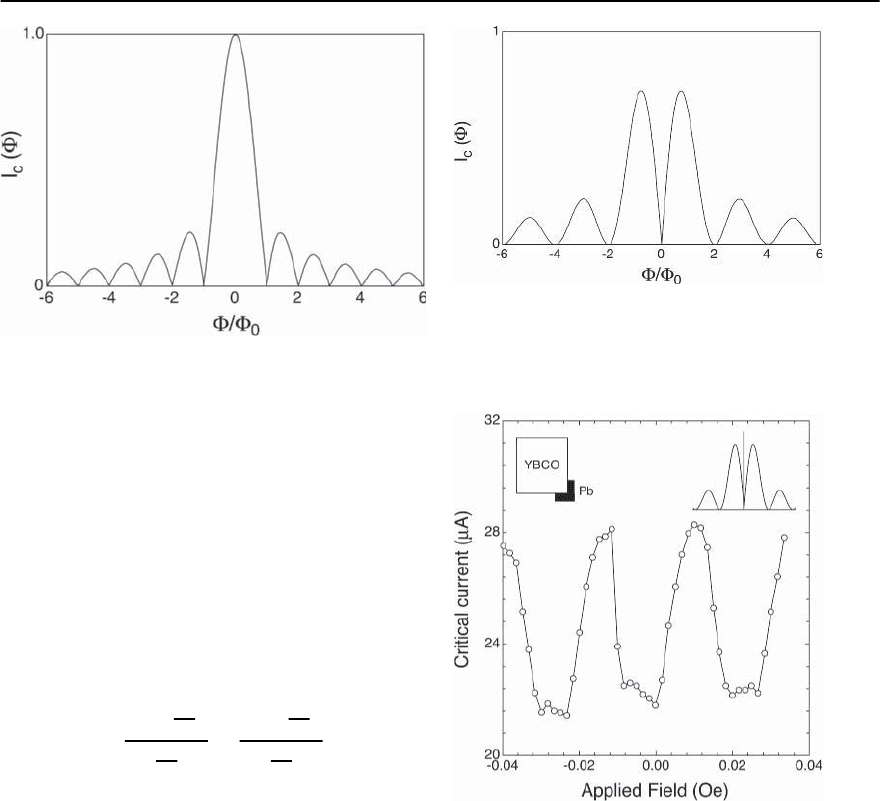
810 H.R.Ott
Fig. 14.65. Fraunhofer type interference pattern of an ex-
tended Josephson junction as a function of magnetic flux
through the junction (see Eq.(14.25))
For individual junctions based on contacts between
a conventional superconductor and a cuprate mate-
rial, essentially the same I
c
behavior is anticipated
for the above mentioned single edge contacts. In case
of an anisotropic order parameter with d
x
2
−y
2
sym-
metry, in contacts straddling a crystal corner in a
more or less symmetrical way, the compensation of
thepositiveandthenegativecurrentsisexpectedto
result in a zero critical current at ¥ =0(mod.)and
hence [229]
I
c
(¥ ) ∼
sin
2
¥
2¥
0
¥
2¥
0
·
sin
2
¥
2¥
0
¥
2¥
0
. (14.26)
This behavior is displayed in Fig. 14.66. Again, con-
tacts along a single edge ought to show a flux depen-
dence according to Eq.(14.25).Since in practice these
corner contacts can never be made exactly symmet-
rical, some asymmetry in the patterns must be antic-
ipated. The key feature, however, remains whether a
dip or a peak in I
c
(¥ ) is observed for single corner
junctions at ¥ = 0. In Fig. 14.67 the result of one
of this type of experiments between Pb and an un-
derdoped single crystal of YBCO-123 is shown [230],
confirming the earlier results of [229], obtained on
optimally doped YBCO-123. The experimental at-
tempts based on the techniques briefly addressed in
(f1) and (f2) have been reviewed in [224].
Fig. 14.66. Expected schematic interference pattern for a
single Josephson junction straddling the corner of a Y-123
single crystal, assuming a d-wave symmetry of the super-
conducting order parameter (see [229])
Fig. 14.67. Magnetic field dependence of the critical cur-
rent I
c
of a corner junction between an underdoped Y-123
single crystal and Pb.Theinsetsshow the schematic exper-
imental configuration and the ideal expected pattern. Note
that I
c
adopts a minimum at zero external magnetic field
(f3) Sc anning SQUID Magnetometry
For a simple closed superconducting loop, the max-
ima of I
c
at ¥ = · ¥
0
imply that the loop may
trap flux quantities given by an integer number of
flux quanta,a situation with zero trapped flux is also
possible.A loop with an odd number of -junctions,
however,will trap fluxes ¥ =( +1/2)·¥
0
.Thismeans
that in order to stabilize, the loop will always gener-
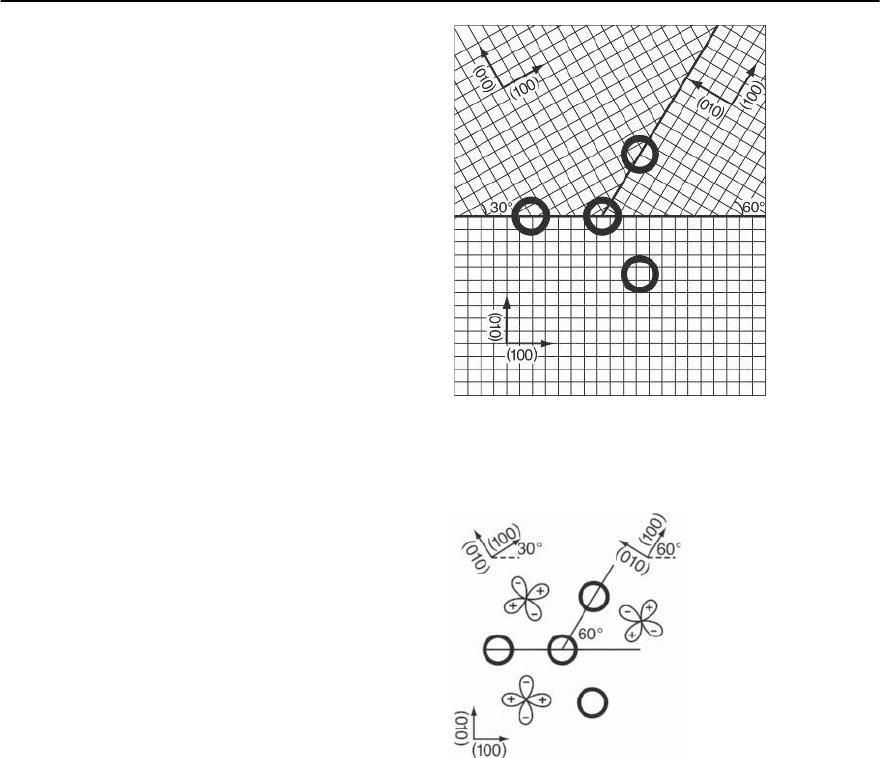
14 High-T
c
Superconductivity 811
ate a spontaneous current, thus inducing a magnetic
moment corresponding to at least one half of a flux
quantum if the external field is set to zero.
In order to test this consequence ofan oddnumber
of -junctions in a loop arrangement, Tsuei, Kirtley
and coworkers designed a really ingenious experi-
ment [231]. In their first attempts, they deposited
small ring-shaped films of YBCO-123 on suitably tai-
lored SrTiO
3
substrates. These substrates were com-
posed of differently oriented single crystals,mended
in such a way that would allow the preparation of dif-
ferent rings, epitaxially deposited on the substrates,
with either an even, including zero, or an odd num-
ber of -junctions. The amount of trapped flux, in-
duced in different ways, was monitored with a scan-
ning micro SQUID probe.It was convincingly shown
that loops with an odd number of -junctions be-
haved differently from those with an even number
or none at all. The original layout of the samples is
schematically shown in Fig. 14.68.With this relative
orientationof thecrystals,therelative orientations of
the d
x
2
−y
2
lobes of the order parameter in the corre-
sponding segments of the YBCO-123 films as shown
in Fig.14.69, areanticipated.With these orientations,
the prediction is that only the loop with its center at
the location where all three crystals meet should ex-
hibit the trapping of half integer fluxes.This is exactly
what the outcome of the experiment confirmed. A
number of additional experiments with either other
choices for the relative orientations of the substrate
crystals [232] or with films of other cuprate super-
conductors, suchas Tl-2201 [233] and Bi-2212 [234],
all confirmed the above result and helped to rule
out extrinsic causes for the observation of half in-
tegerfluxeswhereexpected.Thesametypeofex-
periments also settled an earlier debate concerning
the order parameter symmetry of electron doped
cuprate superconductors. For a while, based on pen-
etration depth experiments, such as mentioned in a
previous subsection, it was claimed that the super-
conducting state of this variety of copper oxides has
to be characterized by an s-wave type pairing. Phase
sensitive measurements using the scanning SQUID
method [235] have shown that also electron doped
cuprates adopt a superconducting state with a gap
of d
x
2
−y
2
symmetry. An extensive review covering
Fig. 14.68. Schematic view of superconducting loops of ring
shaped films of Y-123, deposited epitaxially on a tricrystal
substrate with specially chosen orientations. The central
ring is expected to have one -junction (see [231])
Fig. 14.69. Schematic relative orientation of the d-wave
type order parameter contour in the ring shaped films
(see [225])
the experiments based on the scanning SQUID tech-
nique is given in [225].
(f4) Related Experiments and Problems
In connection with these tunneling experiments is
should also be mentioned that not all of them give
straightforward evidences for the pairing and hence
gap anisotropies discussed above.Results of early ex-
periments probing the Josephson tunneling through
grain boundaries [236] were incompatible with d-
wave pairing in the sense that no complete suppres-
sion of the critical current in the relevant geometry

812 H.R.Ott
of two order parameter lobes with different signs op-
posing each other on either side of the grain bound-
ary could be achieved. It has been suggested [237]
thatinthelongjunctionlimit,thejunctionroughness
may play an important role and that the appearance
of local vortices at the grain boundary may weaken
the expected frustration and therefore allow for non
zero Josephson currents,i.e., currents at zero voltage,
in this case.
Somewhat more complicated is the interpretation
of tunneling experiments where the tunneling cur-
rent is directed along the c -direction of the crystal
lattice.Variousexperimentsinvestigating thistype of
arrangement with contacts between Pb and YBCO-
123 single crystals as well as epitaxial films have been
made [238–240], and non zero Josephson currents
through these junctions were observed. In case of a
strict d-wave anisotropy of the pairing in the plane,
such non zero currents should, of course, be absent.
This apparent inconsistency has been ascribed to the
orthorhombicity of the crystal lattice of YBCO-123
and the corresponding loss of the fourfold rotation
symmetry in the plane [241]. This situation allows
for a mixing of d and s symmetry in the pairing, a
scenario that was early suggested in [242].Therefore,
the observation of non zero Josephson currents may
be explained in this way. More detailed discussions
of these issues are available in [224] and [225].
Consequences of d-Wave Pairing
The now fairly well established dominant d-wave
pairing of quasiparticles in cuprate superconductors
doesnot automatically provide a clear cut conclusion
concerning the nature of the pairing interaction. An
unequivocalidentificationof the pairing mechanism
in cuprates is a formidable task, also in view of the
non Fermi liquid behavior. It was believed that, be-
cause of the appearance of gap nodes, at least an
electron phonon mediated pairing could be ruled
out. Recent Eliashberg-type calculations may indi-
cate that this may not necessarily be true [243].
Nevertheless, the earliest suggestions of a d
x
2
−y
2
-
type pairing symmetry were based on the assump-
tion that the pairing was achieved by exchange of
antiferromagnetic spin excitations. This work has
been reviewed in [191] and [244], see also chapters
by Chubukov et al. and Manske et al. in this volume.
Sinceinthiscaseinthegapequation
(k)=−£
V(k − k
)(k
)
2E(k
)
(14.27)
the interaction V(k − k
)isalwayspositiveandhas
its maxima at the (,)pointsoftheBrillouinzone,
the resulting gap function adopts a d
x
2
−y
2
-type sym-
metry of the form
(k)=
0
(cos k
x
−cosk
y
) . (14.28)
These simple considerations have been comple-
mented by extensive numerical studies cited in [191]
which, for this type of interaction, confirm the sta-
bility of a superconducting state with d
x
2
−y
2
pairing.
Among other consequences, the d-wave pairing
also has some direct influence on the configuration
of the vortices in the mixed state [245,246]. First
of all, singular vortices are no longer expected to
exhibit a circular cross section. Second, the vortex
lattice, exhibiting a hexagonal symmetry in conven-
tional superconductors, has been shown experimen-
tally [247,248] to adopt a rhombohedral symmetry
where the two unit cell vectors are of approximately
equal length, forming an angle of 77 degrees. One
may argue that this again is a consequence of the
d-wave pairing, considering both the distorted cross
section of the single vortices and possible resulting
changes in the interaction between the vortices.
In view of some isotope effect experiments, it
seems that interactions between itinerant quasipar-
ticles and the lattice are of some importance for the
superconductivity in cuprates as well. In general it
is assumed that electron phonon interactions are
not favorable for d-wave pairing. Therefore, it has
been proposed that the pairing or gap symmetry is
a combination mainly of d-wave and s-wave charac-
ter [242]. Even to date the situation is far from being
clear.
14.4.3 Coexistence of Supercond uctivity
and Magnetic Order
The phenomenon of coexistence of magnetic order
and superconductivity was long thought to be im-

14 High-T
c
Superconductivity 813
possible, especially in view of the pair breaking in-
fluence of magnetic fields and magnetic impurities
established for conventional superconductors [249].
Nevertheless, the first examples of the coexistence
of antiferromagnetic order and superconductivity
were reported in the mid seventies in two classes of
compounds, the Chevrel phases (molybdenum sul-
fides and selenides) [250] and the Rhodium–Boron
compounds [251]. In these series, compounds with
rare-earth ionsoccupying regular latticesites may be
prepared. Because of the incompletely filled 4f elec-
tron shells, most of these ions carry respectable ionic
moments resulting from spin and orbital degrees of
freedom. Since these materials are metallic, it is no
surprise that these moments order spontaneously at
low temperatures via the Ruderman–Kittel–Kasuya–
Yoshida (RKKY) interaction mediated by the con-
duction electrons [252]. What is surprising here is
that both the N´eel temperature, fixing the onset of
antiferromagnetic order, and T
c
for superconductiv-
ity are of similar magnitude. This situation has been
studied in great detail for a number of different ma-
terials and reviews of the main results are available
in [253–255], see als chapters by Kuli´c and Buzdin in
volume one of this book.
As we mentioned in Sect. 14.2.2, some cuprates
with rare-earth ions on regular lattice sites may also
be synthesized in the classes of YBCO-123 andYBCO-
124 compounds.Most of the rare-earth elements may
be used to replace Y in these materials. At optimal
doping conditions, i.e., close to seven and eight oxy-
gen atoms per unit formula, respectively, the val-
ues of the critical temperatures of these rare-earth
cuprates are very close to those of the corresponding
Y compounds. In this sense there are no significant
pair breaking effects to speak of. The observation
of antiferromagnetic-type of ordering has been re-
ported for some of them. The ordering temperatures
are rather low and reach a maximum of approxi-
mately 2.2 K for fully oxygenated GdBCO-123 [256].
In most of theother of thesecompoundsthe ordering
sets in below 1 K [257].
It is most likely that both the coexistence phe-
nomenon and the low magnetic transition tempera-
tures are due to the rare-earth site in the YBCO-123
crystal lattice which is situated between the two es-
sential Cu-O planes (see Fig. 14.6(a)). These sites are
electronically quite well separated from the charge
carrier system in the planes and therefore have little
influence on superconductivity. Likewise the RKKY
interaction between these ions is, for the same rea-
son, rather weak. Together with the reduced num-
ber of available excited quasiparticles this implies a
priori a low ordering temperature. It turns out that
the concentration of itinerant charge carriers at the
rare-earth sites is so low that it is doubtful whether
the RKKY interaction is of any significance at all.
The N´eel temperature for antiferromagnetic order
in HoBa
2
Cu
3
O
7
is of the order of 0.1 K [258], most
likely induced by the hyperfine field of the Ho nu-
clei. This is no surprise since the CEF splitting of
the Ho
3+
Hund’s rule J = 8 multiplet leaves a singlet
ground state and the ordered moments of approxi-
mately 2
B
/Ho ion turn out to be much reduced from
thefreeionvalue.
14.5 Physical Properties of Non-Cuprate
High-T
c
Superconductors
In this section, some selected physical properties of
superconductors with unusually high critical tem-
peratures are presented and discussed.None of them,
reaches values that exceed the boiling point of liquid
nitrogen. Nevertheless, the discovery of supercon-
ductivity of these materials and the magnitude of T
c
were and in some cases still are rather surprising,
and therefore of interest.
14.5.1 Ba-Based Oxides
BaPbO
3
, in spite of in principle compensating va-
lences of its chemical constituents, is metallic. The
electrical resistivity is almost temperature indepen-
dent and of the order of a few hundred §cm. Grad-
ually replacing Pb by Bi leads to a structural tran-
sition if about 10% of the Pb content is replaced
by Bi. For BaPb
1−x
Bi
x
, the electrical resistivity in-
creases continuously with increasing x but still stays
more or less temperature independent [51]. Accord-
ing to measurements of the Hall constant R
H
[51],the
charge carrier concentration increases with x, pass-
ing through a maximum at x ≈ 0.25, which appears
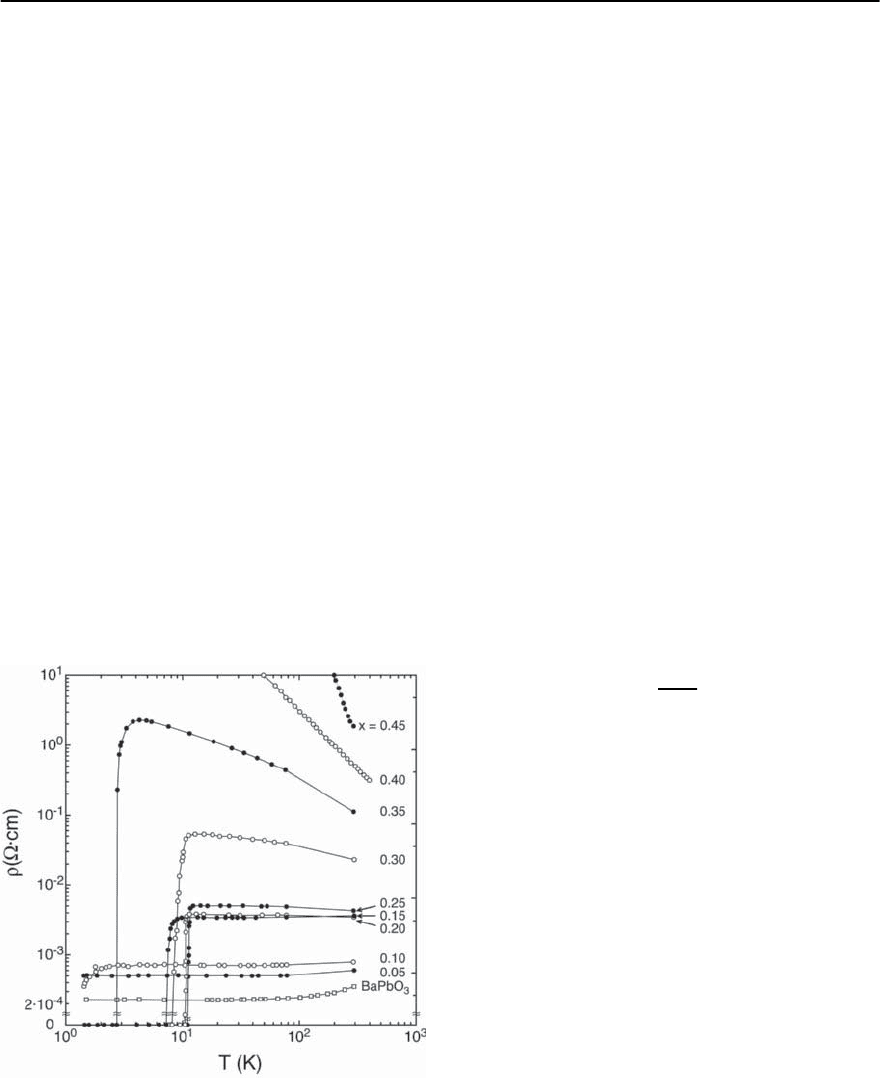
814 H.R.Ott
to be the optimal doping situation for the occurrence
of superconductivity. At this x value, the density of
itinerant charge carriers and the sign of R
H
are com-
patible with one extra itinerant electron per Bi atom.
Conventionally viewed, this concentration of con-
duction electrons is rather low for a superconductor
with a T
c
that exceeds 10 K. In contrast to other ox-
ide superconductors, in particular also the cuprate
superconductors, the bulk magnetic susceptibility
of the normal metallic phase of BaPb
1−x
Bi
x
O
3
is neg-
ative and largest in magnitude at x ≈ 0.25. This
suggests that the paramagnetic contribution to is
weakestatthiscomposition.
Asshownin Fig.14.70,clearresistivetransitionsto
superconductivity are observed for 0.15 < x < 0.35,
but the sharpest transitions at maximum values for
T
c
are observed for x =0.25 [51, 259]. A further
increase of x provokes a reduction of T
c
and even-
tually leads, as indicated by both (see Fig. 14.70)
and R
H
data, to a metal insulator transition which
is accompanied by the already mentioned structural
transition back to an orthorhombicsymmetry of the
crystal structure.
Investigations of the superconducting state [52]
revealed that (BPBO) BaPb
0.75
Bi
0.25
O
3
is an extreme
type II superconductor with a Ginzburg Landau pa-
Fig. 14.70. Variation of the temperature dependence of the
electrical resistivity of BaPb
1−x
Bi
x
O
3
(see [51])
rameter of the order of 70÷80. It appears that the
electronic specific parameter , estimated from a
barely resolvable specific heat anomaly at T
c
and us-
ing Eq. (14.6), is rather small, i.e., ≈ 1.5 mJ/molK
2
,
indicating a low density of electronic states D(E
F
)at
the Fermi energy, usually unfavorable for high crit-
ical temperatures for the onset of superconductiv-
ity.Tunneling data seem to indicate strong electron–
phonon interactions extending in energy into the
range of the superconducting gap in the excitation
spectrum [52,259].If strong coupling effects are im-
portant, the value quoted above is significantly re-
duced and D(E
F
) turns out to be even smaller. From
the theoretical point of view [260] there is no con-
sensus, how the relatively high critical temperature
is to be explained, because the strong-coupling con-
cept is not compatible with band structure calcula-
tions[261] and their connection with the metal to in-
sulator transition mentioned above. In addition, the
ratio 2
0
(0)/k
B
T
c
has been estimated to be 3.5, prac-
tically identical with the weak coupling BCS value.
Some problems are also encountered in the inter-
pretation of measurements of the upper critical field
H
c2
. In the dirty limit, a reasonable choice consid-
ering the resistivity data displayed in Fig. 14.70, the
limiting orbital critical field is given by [262]
H
c2
(0) = −0.691
∂H
c2
∂T
T
c
· T
c
. (14.29)
It appears that the extrapolated experimental limit
of H
c2
(0), based on measurements of H
c2
(T) [52],
shown in Fig. 14.71, by far exceeds the one that is
calculated from the measured initial temperature
dependence of H
c2
just below T
c
, indicated by the
broken line in Fig. 14.71. A clear result is, however,
obtained from measurements of the isotope effect
on T
c
by exchanging
16
Oand
18
Oontheoxygen
sites [263]. The heavier oxygen isotope leads to a
significant reduction of the critical temperature and
the value of the parameter ˛ entering Eq. (14.10)
has been calculated to be ˛ =0.22. Although this
result seems to confirm that most likely the occur-
rence of superconductivity in the Pb/Bi oxides is
due to an electron phonon interaction, it has been
argued that electronic excitations involving atomic
displacements due to charge redistributions are me-
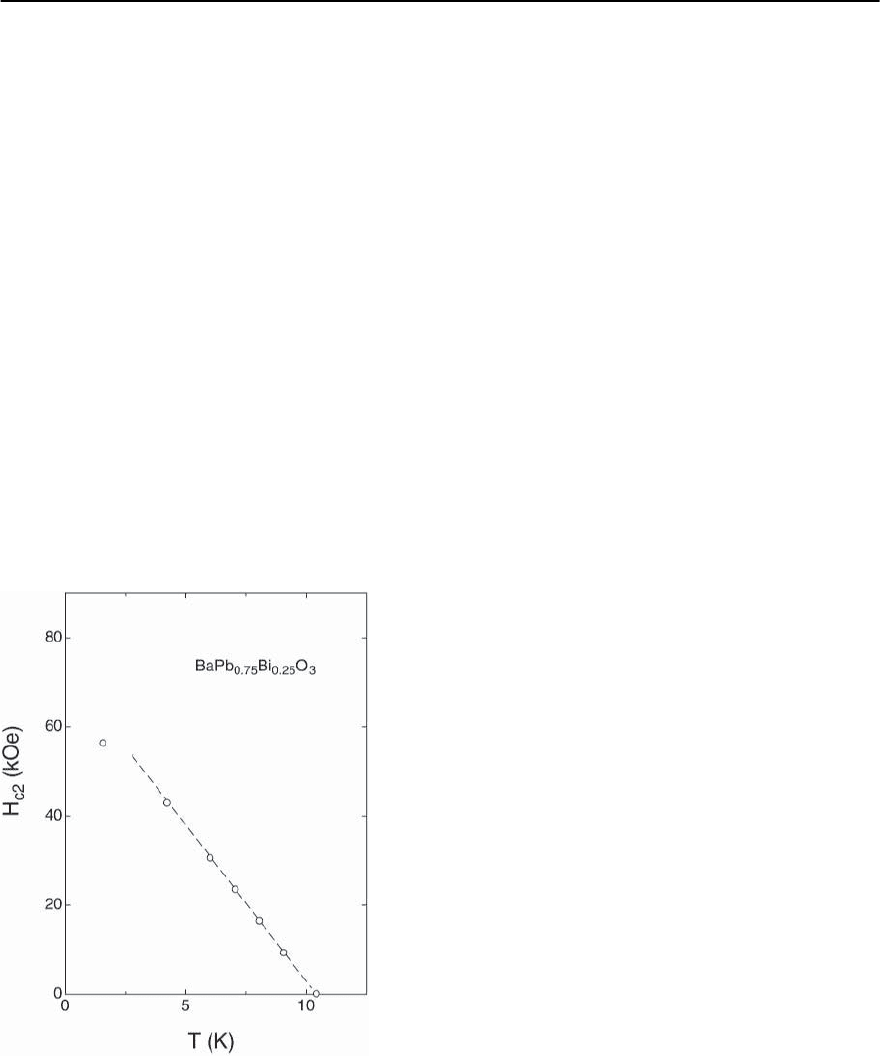
14 High-T
c
Superconductivity 815
diating the pairing interaction[263].This conclusion
is based on considering the relatively high value of
T
c
and indications that pairing in BPBO is a weak
coupling effect.
The observation of critical temperatures that are
more than twice as large as those of the Pb/Bi alloys
and comparable to some of the cuprate supercon-
ductors, i.e., of the order of 30 K, for Ba
0.6
K
0.4
BiO
3
(BKBO) [54,55], naturally led to additional experi-
ments probing the physical properties of this com-
pound [263, 264]. In particular, a comparison with
some of the properties of the cuprate superconduc-
tors was attempted. The total normal state magnetic
susceptibility again reveals a strong core diamag-
netism which, overall, masks a very weak paramag-
netic contribution[263,264].Normal state Hall effect
measurements [264] revealed that R
H
is weakly tem-
perature dependent and negative at all temperatures
below 300 K. This confirms that the Bi-based oxides,
without Cu,however,are electronically and magneti-
cally quite different species than the hole doped cop-
per oxides.
Fig. 14.71. Temperature dependence of the upper critical
field H
c2
of BaPb
0.75
Bi
0.25
O
3
.Thebroken line is to guide the
eye (see [52])
The response of the superconducting state to ex-
ternal magnetic fields is rather similar to that of the
Pb/Bi alloys, leading to almost the same values of
(∂H
c2
/∂T)
T
c
,oftheorderof−5kOe/K.Estimatesof
theGinzburg–Landau parametergive ≈ 45,again a
large value. As for the Pb/Bi alloys this is compatible
with a low density of itinerant carriers and conse-
quently a large penetration depth .Fromavailable
experimental results covering the upper and lower
critical fields,H
c2
(T)andH
c1
(T),estimates of theini-
tial temperature dependence of the thermodynami-
cal critical field (∂H
c
/∂T)
T
c
can be made. Finally, us-
ing the law of corresponding statesallowsto calculate
the electronic specific heat parameter or effective
density of states D(E
F
). Although somewhat larger
than the corresponding value calculatedfor the Pb/Bi
alloy,also D(E
F
) for the Ba/K alloy is much too small
to account for a T
c
of the order of 30 K in any con-
ventional way. Nevertheless, also for this material, a
significant oxygen isotope effect confirms that some
type of electron phonon interaction must be impor-
tant for the onset of superconductivity [263]. The
values for the ˛ parameter differ somewhat in dif-
ferent reports; ˛-values between 0.21 and 0.35 have
beencalculated[263,264].Again,conventionalstrong
coupling effects have been ruled out.
For (Ba/K)BiO
3
, measurements aiming at prob-
ing the symmetry of the superconducting state have
been made [265].Corner-junctiontype experiments,
exploring the field dependence of the critical cur-
rent I
c
(¥ )(see Eq. (14.26)), indicate that the super-
conducting state of this alloy is characterized by a
nodeless gap function or order parameter.
14.5.2 C
60
-Based Materials
As we have briefly mentioned in Sect. 14.3.3 the sim-
plest way to achieve a metallic state in bulk C
60
-based
material is via electron doping with atoms of the
alkaline metal elements. Most of the experimental
results that are briefly discussed below have been
obtained for compounds of the type A
3
C
60
.Some
combinations of this type turn out to be electrical
insulators. Based on calculations of the widths W
of the essential electronic energy bands and the on-
site Coulomb correlation energies U,indicating that
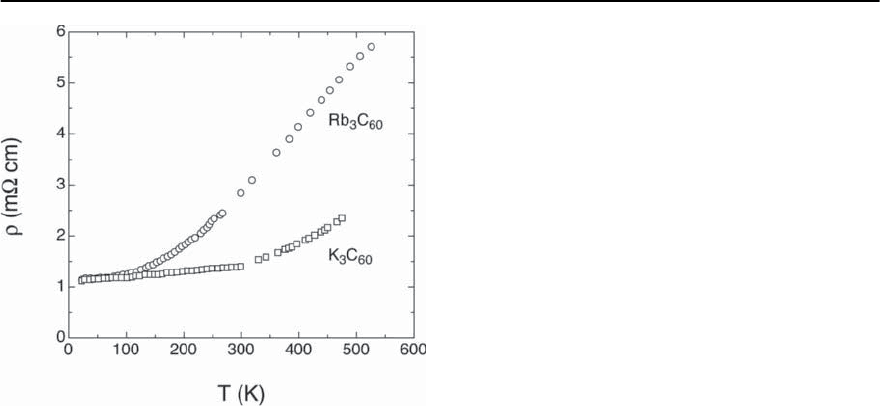
816 H.R.Ott
Fig. 14.72. Temperature dependence of the electrical resis-
tivityof thin films of K
3
C
60
and Rb
3
C
60
(see [269])
the ration U/W significantly exceeds the value of
1, it is argued that the metallic species are on the
metallic side of a metal insulator transition of Mott–
Hubbard type and therefore, correlation effects have
to be taken into account [266,267].Anotherdifficulty
arises, because the energies of the relevant phonon
branches are not very different from W and hence,
invoking Migdal’s theorem [268] for justifying the
electron pairing via a retarded electron–phonon in-
teraction is questionable.
The absolute values of the electrical resistivities
are rather high and correspond to electronic mean
free paths of the order or even less than the separa-
tion between single molecules. Examples of (T)of
superconducting A
3
C
60
films are shown in Fig. 14.72
[269]. Even at very low temperatures and for single
crystalline samples, the absolute values of are of
the order of 1 m§ cm. In most cases the low temper-
ature electrical resistivities vary as T
2
[270] but also
linear-in-T or T-independent variations down to low
temperatures, depending on the sample configura-
tion (film, crystalline, granular) have been reported.
It is therefore clear that a theoretical treatment of this
transport property is difficult,even more so, because
it seems to matter whether (T) is measured at con-
stant volume or at constant pressure. Nevertheless,
calculations invoking the interactions between con-
duction electrons and various lattice modes may be
brought into reasonable agreement between exper-
iments, carried out under constant pressure condi-
tions, revealing ∼ T
2
, and theory. A renormaliza-
tion of the same data to constant volume conditions
reveals that varies approximately linearly with T
above 100 K [271]. This result has apparently not yet
found a theoretical explanation. Although the very
short mean free path at temperatures of the order of
300 K might suggest a saturation behavior in (T)at
even more elevated temperatures, this phenomenon
is, very much like in the case of the cuprates, not ob-
served. In spite of the similarity of these features in
(T) of the two types of materials, it seems quite un-
likely that the same scattering processes are the cause
for this observation.
Quite generally, the magnetic susceptibility in
the normal state is positive and almost temperature
independent [272],as is also found for the resonance
shift in NMR measurements [273]. Comparing the
magnitude of experimental data with values cal-
culated from band structure data suggests that a
rather substantial enhancement of must be con-
sidered [272]. The corresponding density of states
D(E
F
) (see Eq. (14.4)) is larger by a factor of 3 than
the bare density of states D
b
(E
F
) that follows from
the band structure, but in fair agreement with esti-
mates of D(E
F
) based on NMR spin-lattice relaxation
data [273].Asexpected formetals,the spin-latticere-
laxation rate T
−1
1
is approximately linear in T in the
normal state, however, the hyperfine coupling con-
stant is not known very well.
Apart from the clear manifestations of the super-
conducting transition in (T)and(T)thetransi-
tion is, as usual, also manifest in experimental data
of a number of other properties. This is certainly the
case for measurements probing the specific heat.Be-
cause of the fragility of the materials, especially with
respectto airexposure,thesemeasurements[272] are
technically not trivial.Asdemonstrated in Fig. 14.73,
the specific heat anomaly at T
c
is masked by a large
background of non electronic origin, but estimates
concerning its magnitude can still be made. For
K
3
C
60
, the ratio of C(T
c
)/T
c
is of the order of 70
mJ/mole K
2
, a rather small value but confirming the
rather low effective electronic density of states at E
F
.
